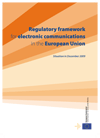
The revised EU framework constitutes the basis for a supportive and consistent regulatory environment targeting remaining challenges. They reinforce competition while enhancing incentives to invest. New provisions on freeing radio spectrum will improve the availability of new wireless services, including wireless broadband, at reasonable costs. The new body of European regulators (BEREC) will improve cooperation between national regulators and the European Commission. This will lead to the creation of a common "regulatory culture", to more consistency, and to a real single market for electronic communications networks and services.
The revised EU framework will thus better meet the future challenges arising from a rapidly evolving sector. Its timely implementation is essential and will ultimately benefit the European economy and society by providing it with the advanced electronic communications infrastructure it needs for its growth.
This collection of texts, which includes a consolidated version of the electronic communications reform package as amended in 2009, will prove a very useful resource for all those concerned with the application of law in the electronic communications sector.
Fabio Colasanti
Director General
Information Society and Media Directorate General
Download Regulatory Framework for Electronic Communications in the European Union (.pdf, 4.348 KB).
Download from eHealthNews.eu Portal's mirror: Regulatory Framework for Electronic Communications in the European Union (.pdf, 4.348 KB).